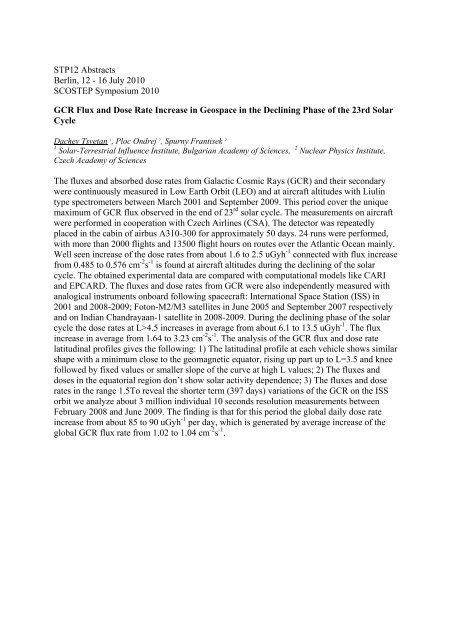scostep 2010 (stp12) - Leibniz-Institut für Atmosphärenphysik an der ...
scostep 2010 (stp12) - Leibniz-Institut für Atmosphärenphysik an der ...
scostep 2010 (stp12) - Leibniz-Institut für Atmosphärenphysik an der ...
You also want an ePaper? Increase the reach of your titles
YUMPU automatically turns print PDFs into web optimized ePapers that Google loves.
STP12 Abstracts<br />
Berlin, 12 - 16 July <strong>2010</strong><br />
SCOSTEP Symposium <strong>2010</strong><br />
GCR Flux <strong>an</strong>d Dose Rate Increase in Geospace in the Declining Phase of the 23rd Solar<br />
Cycle<br />
Dachev Tsvet<strong>an</strong> 1 , Ploc Ondrej 2 , Spurny Fr<strong>an</strong>tisek 2<br />
1 2<br />
Solar-Terrestrial Influence <strong>Institut</strong>e, Bulgari<strong>an</strong> Academy of Sciences, Nuclear Physics <strong>Institut</strong>e,<br />
Czech Academy of Sciences<br />
The fluxes <strong>an</strong>d absorbed dose rates from Galactic Cosmic Rays (GCR) <strong>an</strong>d their secondary<br />
were continuously measured in Low Earth Orbit (LEO) <strong>an</strong>d at aircraft altitudes with Liulin<br />
type spectrometers between March 2001 <strong>an</strong>d September 2009. This period cover the unique<br />
maximum of GCR flux observed in the end of 23 rd solar cycle. The measurements on aircraft<br />
were performed in cooperation with Czech Airlines (CSA). The detector was repeatedly<br />
placed in the cabin of airbus A310-300 for approximately 50 days. 24 runs were performed,<br />
with more th<strong>an</strong> 2000 flights <strong>an</strong>d 13500 flight hours on routes over the Atl<strong>an</strong>tic Oce<strong>an</strong> mainly.<br />
Well seen increase of the dose rates from about 1.6 to 2.5 uGyh -1 connected with flux increase<br />
from 0.485 to 0.576 cm -2 s -1 is found at aircraft altitudes during the declining of the solar<br />
cycle. The obtained experimental data are compared with computational models like CARI<br />
<strong>an</strong>d EPCARD. The fluxes <strong>an</strong>d dose rates from GCR were also independently measured with<br />
<strong>an</strong>alogical instruments onboard following spacecraft: International Space Station (ISS) in<br />
2001 <strong>an</strong>d 2008-2009; Foton-M2/M3 satellites in June 2005 <strong>an</strong>d September 2007 respectively<br />
<strong>an</strong>d on Indi<strong>an</strong> Ch<strong>an</strong>draya<strong>an</strong>-1 satellite in 2008-2009. During the declining phase of the solar<br />
cycle the dose rates at L>4.5 increases in average from about 6.1 to 13.5 uGyh -1 . The flux<br />
increase in average from 1.64 to 3.23 cm -2 s -1 . The <strong>an</strong>alysis of the GCR flux <strong>an</strong>d dose rate<br />
latitudinal profiles gives the following: 1) The latitudinal profile at each vehicle shows similar<br />
shape with a minimum close to the geomagnetic equator, rising up part up to L=3.5 <strong>an</strong>d knee<br />
followed by fixed values or smaller slope of the curve at high L values; 2) The fluxes <strong>an</strong>d<br />
doses in the equatorial region don’t show solar activity dependence; 3) The fluxes <strong>an</strong>d dose<br />
rates in the r<strong>an</strong>ge 1.5To reveal the shorter term (397 days) variations of the GCR on the ISS<br />
orbit we <strong>an</strong>alyze about 3 million individual 10 seconds resolution measurements between<br />
February 2008 <strong>an</strong>d June 2009. The finding is that for this period the global daily dose rate<br />
increase from about 85 to 90 uGyh -1 per day, which is generated by average increase of the<br />
global GCR flux rate from 1.02 to 1.04 cm -2 s -1 .











